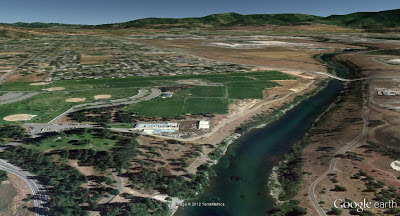I was searching for something else entirely and came across this little item from the
December 3, 1940 issue of the Spokesman Review:
What a proud and handsome young man! I had to wonder though--what fate befell this young man who entered the Army Air Corps a year before Pearl Harbor?
The Army Air Corps was expanded by Congress in 1939, and Croteau,
a recent graduate of Gonzaga University, was one of hundreds of new pilots being recruited. Kelly Field was a
training base in San Antonio. As Croteau went to Kelly Field, Europe was awash in war, the Japanese Army had conquered much of China and southeast Asia, and the United States was preparing to enter the global conflict. So what happened to our smiling lad from Wallace?
Croteau was assigned to the 83rd Squadron, 12th Bomb Group (M), of the 9th United States Army Air Force at Ismailia, Egypt. He piloted a B-25 in support of allied troops at the
Battle of El Alamein. I know this because of
this web page that describes the wartime service of Roland Rakow, the lower turret gunner on Croteau's bomber. Let's let Rakow tell the story:
On September 1, 1942, as our B-25 was returning from its second completed mission—dropping its bomb load on tanks, trucks and troops on the front line at El Alamein—it was struck by a German anti-aircraft 88 mm shell on the left side of the aircraft, adjacent to the top turret gun position. The shell made a gaping hole, which caused the aircraft to break open and go into a 30-or 40-degree dive.
The bombardier, navigator, and the top turret gunner were unable to leave the aircraft. The pilot, co-pilot, and I (the radio operator) parachuted to the ground. We sustained wounds and injuries.
“The aircraft crashed in the desert. Capt. Croteau—who was slightly injured—and Lt. Biers located the crash site and found the bodies of Lt. McPartlin and Lt. Archer still in the aircraft. Not wanting to leave their bodies, they buried them at the site. Sergeant Andersen’s body was not found.
I had parachuted to a different location. Within a short period of time, Capt. Croteau and Lt. Biers were discovered and taken prisoner by the German Army. Subsequently, they were transported to a German POW camp and they remained there for the duration of the war.
Rakow was sent to a prison camp in Italy from which he eventually escaped, making his way back to Allied lines and was returned to the States for medical treatment. At the end of his narrative he notes: "I have never been in contact with Capt. Croteau or Lt. Biers, the remaining survivors of my B-25 crew. However, I did hear from other members of our 83rd Squadron that Capt. Croteau had passed away."
Croteau had not passed away, however. He survived the war and returned to the Northwest. Croteau married, had a child, worked for Uniroyal and Delta, and lived until 2006, when he died at the ripe old age of age of 87 in Beaverton, Oregon.
Here is his grave. His obituary notes that he was a prisoner of war for 32 months. Croeau lived for over 64 years after he was shot down, wounded, and taken prisoner in 1941, and more than 60 years after his crew mate Rakov reported his death.





